Some background
The McNicol Opera House, on Market Street between Third and Fourth Streets, opened to the, public in 1881. The three-story brick structure had a seating capacity for eight hundred patrons. In succeeding years, under the names of the East Liverpool Opera House and the Brunt Opera House, the "elegant" house delighted local patrons with a variety of presentations. On 31 October the "best show of the season . . . 6 Peas in a Pod" was presented by Rentfrow's Jolly Pathfinders, accompanied by music featuring the Silver Coronet Band and an Operatic Orchestra. During the 1886 season, stars such as Mattie Vickers, Lilly Clay, and Cora Van Tassell appeared in East Liverpool in such plays as Skipped by the Light of the Moon, the "comedy sensation of modern times." In 1886 when a second entertainment hail opened in the town, the editor of the Review, perhaps a little excited, announced that, "East Liverpool is fast assuming metropolitan proportions." When the new Mozart Hall on Sixth Street opened to a "packed house," the editor was in attendance. He thought the presentation was "varied and highly amusing entertainment, at the same time moral in its tendencies, being entirely free from the vulgarity, low slang and sensationalism so often found in the popular amusements of the day.""
During much of the year residents continued to enjoy swimming, picnics, and excursions on the Ohio River." A great many of the outings revolved around the picnics, suppers, and other events local potteries sponsored for their employees and families. Brunt, Bloor, Martin and Company printed formal invitations to its "First Annual Picnic and Dance" on 30 August 1880. Over five hundred locals attended the joint Harker's picnic of the "Etruria" and "Wedgewood" potteries at "Rock Spring Grove" that same year. Employees of the Cartwright Brothers and C.C. Thompson potteries were treated to an excursion to Cleveland. In 1880 the Laughlin pottery leased five cars from the Cleveland and Pittsburgh Railroad Company and transported three hundred employees to Pittsburgh for a day at the "expo" and an opera in the evening. One of the most popular places during this period to have a large organized picnic, or a small informal one, was Rock Springs Grove located across the river in Hancock County, West Virginia. The grounds were easily accessible by ferry from East Liverpool and provided a welcome respite from the dirt and noise of the industrialized city. Clean, clear water from natural springs "surrounded by beautiful scenery" made Rock Springs "a cool, and in every way, inviting retreat." By 1887 the inevitable commercialism had entered into the area and the "pleasure grounds" also included a dancing platform, cafe, shooting gallery, dining hail, and a bowling alley. Source of Information: The City of Hills and Kilns. Life and Work in East Liverpool, Ohio William C. Gates, Jr. East Liverpool Historical Society, (1984)pp. 140-41.
Following the uncertainty at mid-decade, the construction of new streetcar lines and the development of new sections of the city and its surrounding area proceeded at a remarkable pace. The construction of a bridge spanning the Ohio River between Ohio and West Virginia at East Liverpool was contemplated as early as 1889. The project was revived in 1893 by J.E. McDonald, an East Liverpool attorney who purchased the Marks farm across the Ohio River in West Virginia. In April of 1893 McDonald announced that the East Liverpool Bridge Company, chartered in the State of West Virginia, had been organized to construct the bridge and that twenty thousand dollars in stock subscriptions had already been secured in Hancock County, West Virginia. He hired engineers to survey the area for the best location of the bridge and began to solicit subscriptions in East Liverpool for the balance of the stock. The editor of the Crisis was excited about the prospect of the bridge, citing the deficiencies of depending on ferry service and describing the benefits to the city and the area across the river. The project was temporarily abandoned because of the Panic of 1893. Three years later, in January 1896, the plan was revived and construction began. By this time the city council had authorized the company to locate the entrance to the bridge on city property and it had been secured by the company, which consisted of McDonald, W.L. Smith, A.R. Mackall, other local capitalists, and J.G. Kerny of Montreal." Source of Information: The City of Hills and Kilns. Life and Work in East Liverpool, Ohio William C. Gates, Jr. East Liverpool Historical Society, (1984)pp. 186-88.
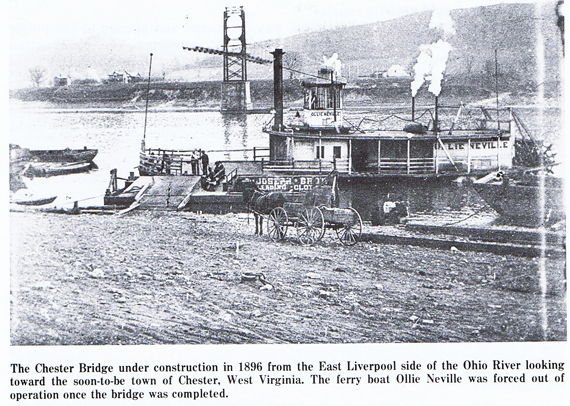
Ferry prior to the bridge. Chester Bridge being constructed.
McDonald and his associates also formed the Chester Land Company to develop the 475 acres of land they owned. This land included Rock Springs Park, which they planned to enlarge and develop as a resort. Additionally, the investors intended to connect the "Crockery City" with their new town by a street railway across the bridge.
Looking from the Chester side towards East Liverpool. Picture taken of a picture found in the Travelers Hotel.
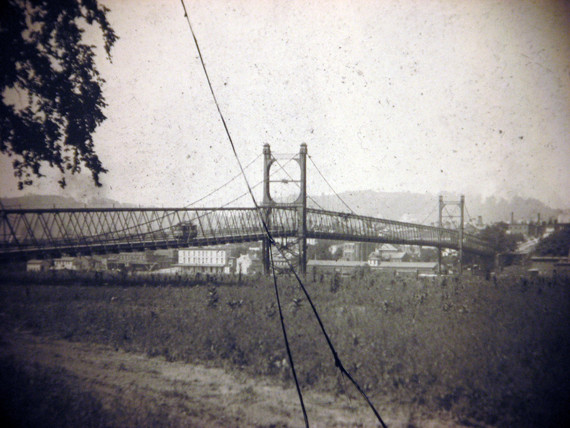
The most popular park for East Liverpool citizens and other tn-state residents, however, was Rock Springs Park in Chester, West Virginia. Not only was it the most popular, but Rock Springs Park was also the most developed and commercialized of all the area's parks. During the late 1880s and early 1890s, the park was operated as a picnic grounds and was slowly improved by the addition of a dancing pavilion, eating areas, and a small merry-go-round. In 1896 the park was purchased by the owners of the East Liverpool Bridge Company and plans were adopted to construct a huge amusement park covering the bulk of the property. The new proprietors spent over twenty-five thousand dollars on a new enclosed dancing pavilion which could accommodate five thousand people. They also built a modern cafe, a shooting gallery and bowling alley, and three roller coasters. With the opening of the Chester Bridge in January of 1897 and the new streetcar line, an estimated five thousand people flocked to the new park on its Memorial Day opening. In 1900 C.A. Smith purchased the park and in subsequent years added numerous new attractions. A ". . . magnificent 150-light, multicolor electrical fountain ..." was added in 1901. Two years later he added the "Old Mill," a boat ride in a zig-zag course through a building fifteen hundred feet long divided into seven large rooms; a "laughing gallery;" "mechanical wings;" and a "pleasure palace" containing electric machines and music boxes. When the new fourteen hundred seat vaudeville theatre with a stage 40 by 70 feet was opened in May of 1903, it inspired the editor of the Tribune to state that the improvements had made the park ". a veritable paradise of cool comfort, green grass, delightful shade by day and an electric wonder by night" In 1904 an artificial lake, a bath house, and a swimming pool measuring 70 by 170 feet were constructed. When the swimming pool was opened in the summer, "colored picnickers" were prohibited from using it, but they were allowed to enjoy the lake and all the other amusements.10'
Throughout the balance of the decade, new rides, including the "shoot-the chutes," the scenic railway, and a larger roller coaster and merry-go-round were added. Special excursion rates on the railroad from Pittsburgh, Wheeling, and other tn-state locations encouraged visitation; tourists kept the park crowded throughout its summer seasons. Following the annual closing of the park in September of 1906, park officials reported that approximately 125,000 people had taken advantage of the excursion fares. In addition to providing a place for children and adults to picnic, frolic, and experience the thrilling rides, the park was an economic benefit to East Liverpool and the surrounding area. By 1906 Rock Springs Park employed over 350 workers at its numerous attractions. In addition, local potteries received many orders for dinnerware sets from out-of- town visitors and supplied souvenir plates for the park. Source of Information: The City of Hills and Kilns. Life and Work in East Liverpool, Ohio William C. Gates, Jr. East Liverpool Historical Society, (1984)pp. 244-45.
During the spring of 1896 the promoters surveyed the land and began to plat it into lots. In early July they began to advertise the advantages of the lots 'in [the] new South side suburb at the West Virginia end of the bridge" that would be for sale as of 20 July. Advertisements stated that the new town would enjoy every modern improvement which East Liverpool had and that residents could get gas, telephone, electric, water, and connection with the street railway without paying East Liverpool taxes. McDonald stated that the new area offered plenty of space for the expansion of the rapidly growing pottery industry. The land company placed six hundred lots on sale and the response was good. They reserved about two hundred acres at the eastern end of the property which they planned to donate to prospective manufacturing enterprises. In 1899 the town of Chester, West Virginia was granted a charter. 13
The Chester Bridge, as it was named, was completed and opened to the public on 31 December 1896. Costing over $200,000 to construct, the combination suspension and truss bridge provided a link to a large area of level land. After a little more than a year, the bridge company went into receivership when it could not pay the interest due on its bonds. The bridge was operated by the receivers for about three years. C.A. Smith eventually gained controlling interest in the company and the bridge was later sold to the East Liverpool Traction and Light Company.'4
In the meantime McDonald and his associates began making arrangements for a streetcar line to traverse the new bridge and make their new town more accessible. A dispute over the new line developed between McDonald and East Liverpool officials. Under the terms of McDonald's original proposal, the new line to the Pennsylvania state boundary. Alex G. Chaffin platted a new suburb west of Pennsylvania Avenue and built several houses in 1900. The Supplee Land Company was formed in March 1901 and purchased a tract containing about twenty-one acres which it platted into residential lots. The Island Avenue Land Company platted 169 lots east of Sebring's Klondyke pottery in May 1902 and sold them for prices ranging from fifty dollars to $250. In November 1902 the Midway Land Company began developing a residential area between the central city and the east end along Pennsylvania Avenue. The Cleveland and Pittsburgh Railroad Company announced in January 1902 that it planned to build a depot and freight station in the east end at a point opposite the National pottery. Pottery manufacturers and residents alike hailed the news. The editor of the Crisis, citing the number of new merchants and residents, stated in the fall of 1902 that the east end was enjoying an era of business prosperity. The only thing holding the suburb back, he added, was the lack of houses, although they were rapidly being built.'8. THe City of Hills and Kilns, pp 184-190.
Chester and Rock Springs Railway Company
Trolleys lined up on Union Street between East Second Street and East Third Street either taking on passengers for a day at Rocks Springs Park or discharging passengers after a day at Rock Springs Park.
The time period is probably late 1890s or early 1900s.
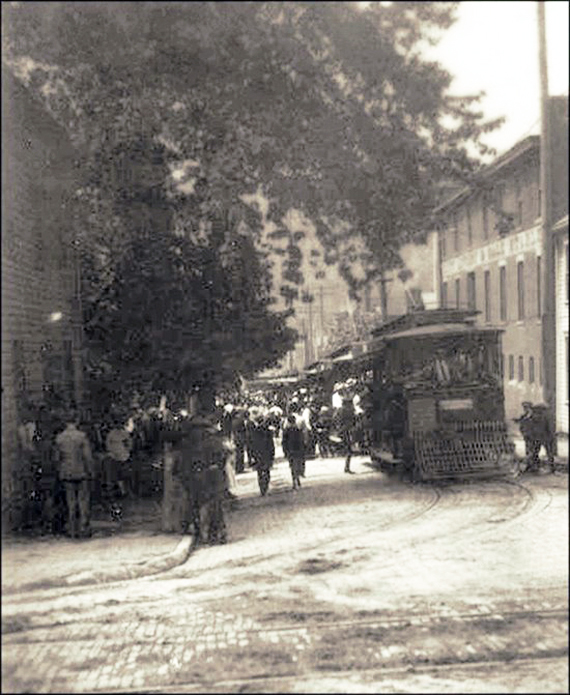
The Chester and Rock Springs Railway Company/East Liverpool and Rock Springs Railway operated from 1897 to 1905. It was absorbed by the East Liverpool Traction and Light in 1905. (Ghost Rails III Electrics by Wayne A. Cole. 2007 p. 164.
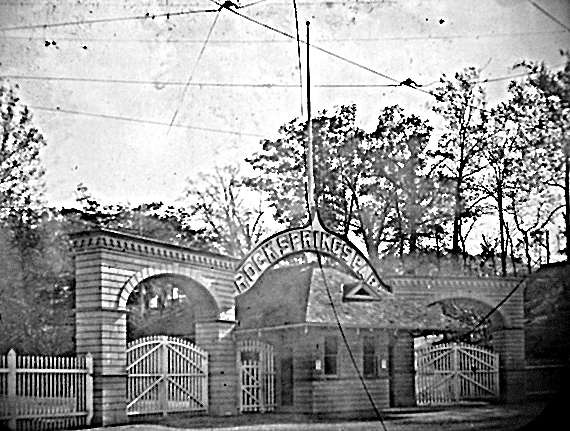
Entrance to Rock Springs Park. Notice the trolley wires.

A slightly different angle, you can see trolley tracks.
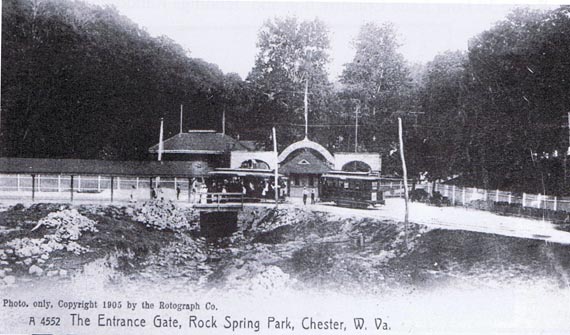
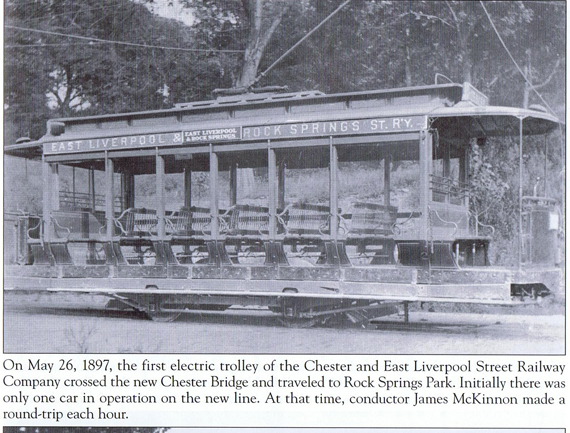
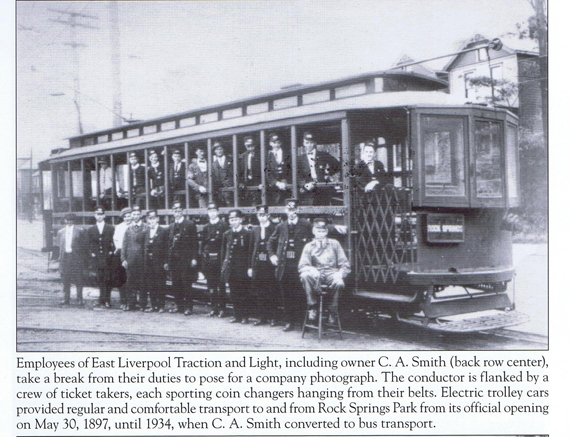
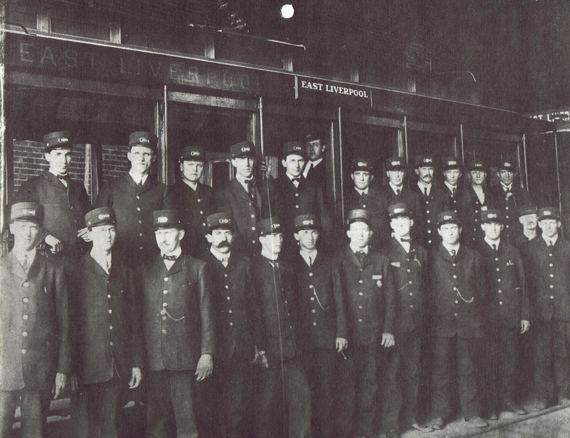
Employees of the East Liverpool & Rock Springs Park Street Car Company in 1911. Sunday Nov. 12, 1911, 4:30.
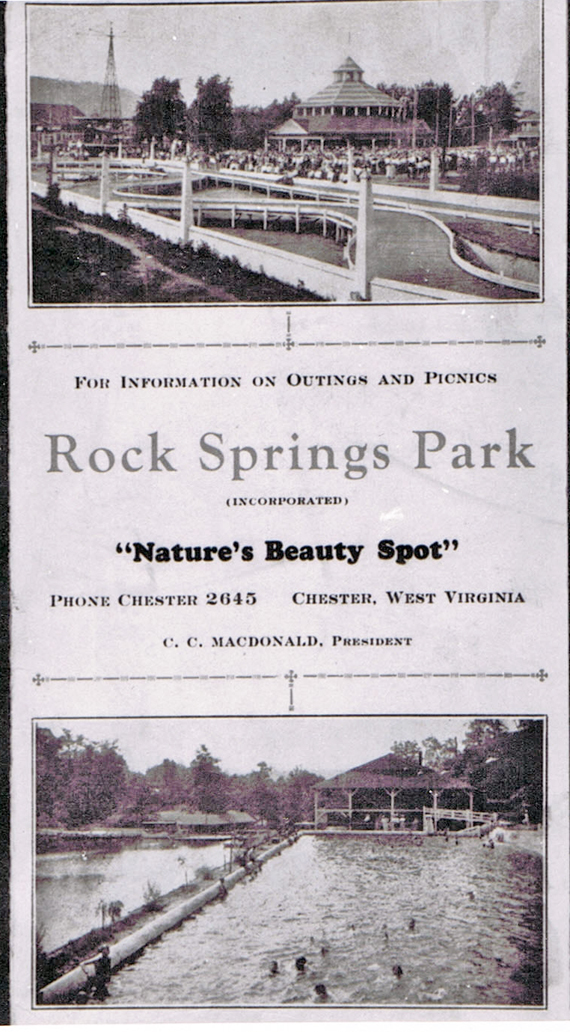
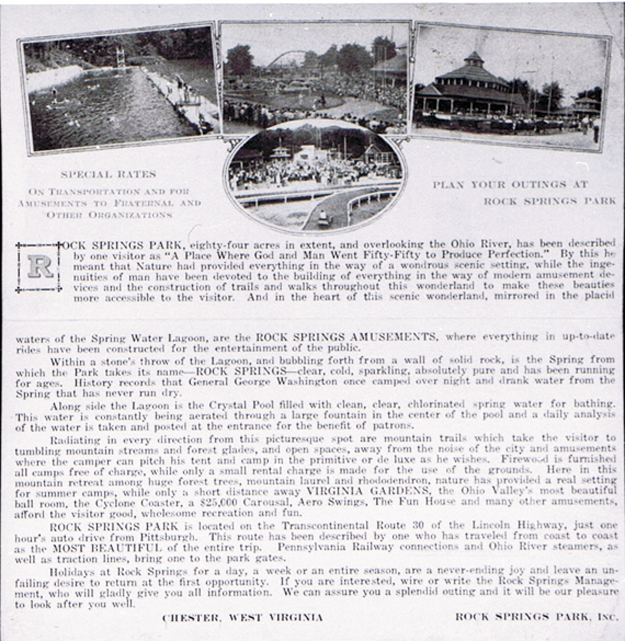
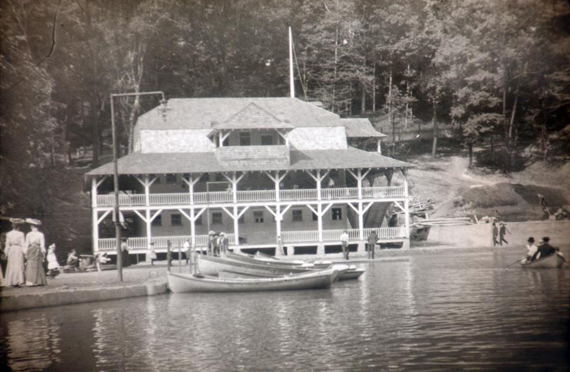
Rock Springs Park --Lake boat landing and boat house. Swimming Pool under construction. Note ladies fashions Dr. Birkett Magic Lantern Glass Slides #8
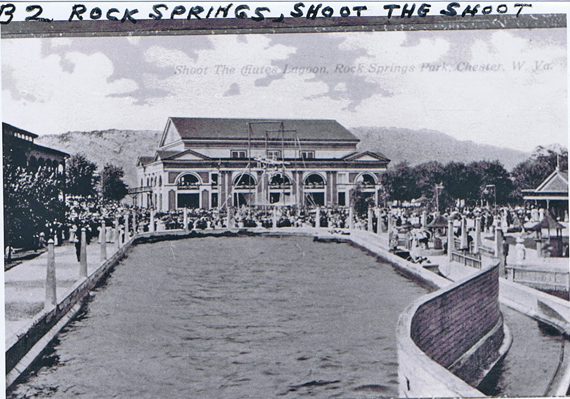
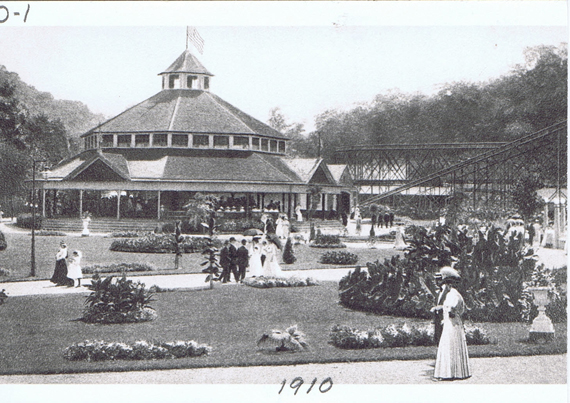
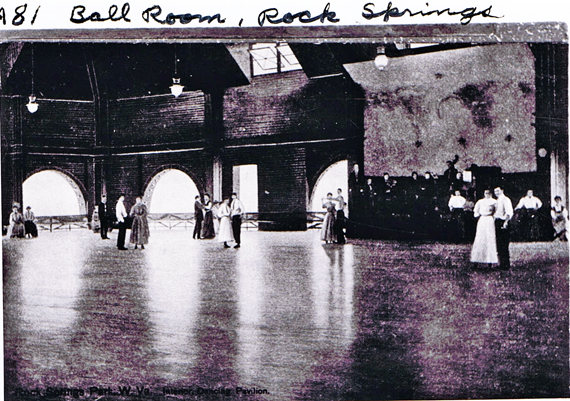
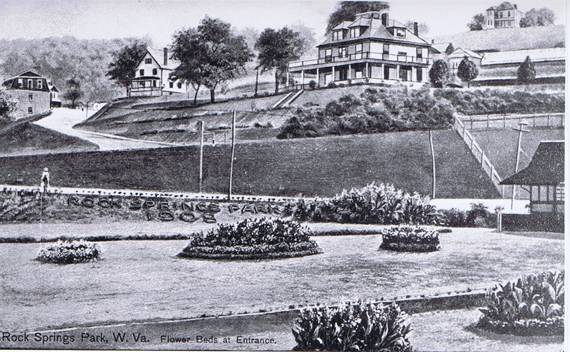
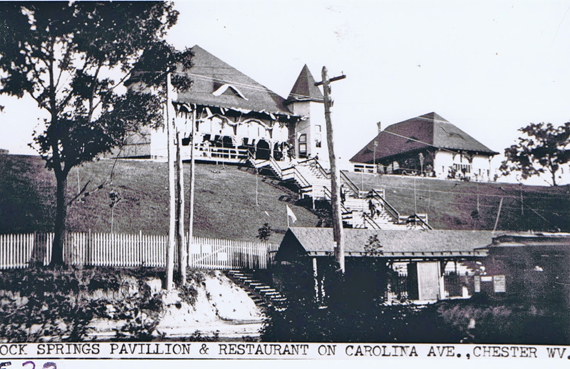
A different view, probably a different time period.

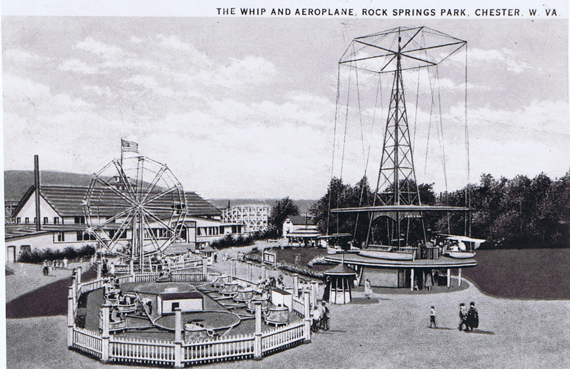
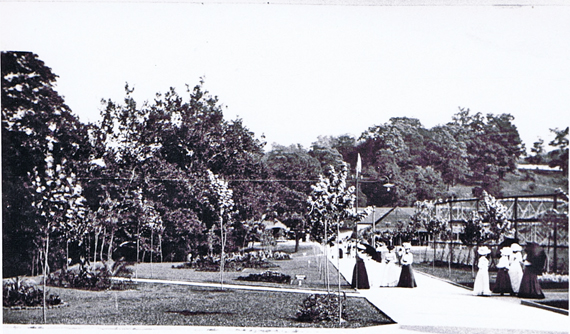
CONTIUE ON TO Rock Springs Park 2
This site is the property of the East Liverpool Historical Society.
Regular linking, i.e. providing the URL of the East Liverpool Historical Society web site for viewers to click on and be taken to the East Liverpool Historical Society entry portal or to any specific article on the website is legally permitted.
Hyperlinking, or as it is also called framing, without permission is not permitted.
Legally speaking framing is still in a murky area of the law though there have been court cases in which framing has been seen as violation of copyright law. Many cases that were taken to court ended up settling out-of-court with the one doing the framing agreeing to cease framing and to just use a regular link to the other site.
The East Liverpool Historical Society pays fees to keep their site online. A person framing the Society site is effectively presenting the entire East Liverpool Historical Society web site as his own site and doing it at no cost to himself, i.e. stealing the site.
The East Liverpool Historical Society reserves the right to charge such an individual a fee for the use of the Society’s material.